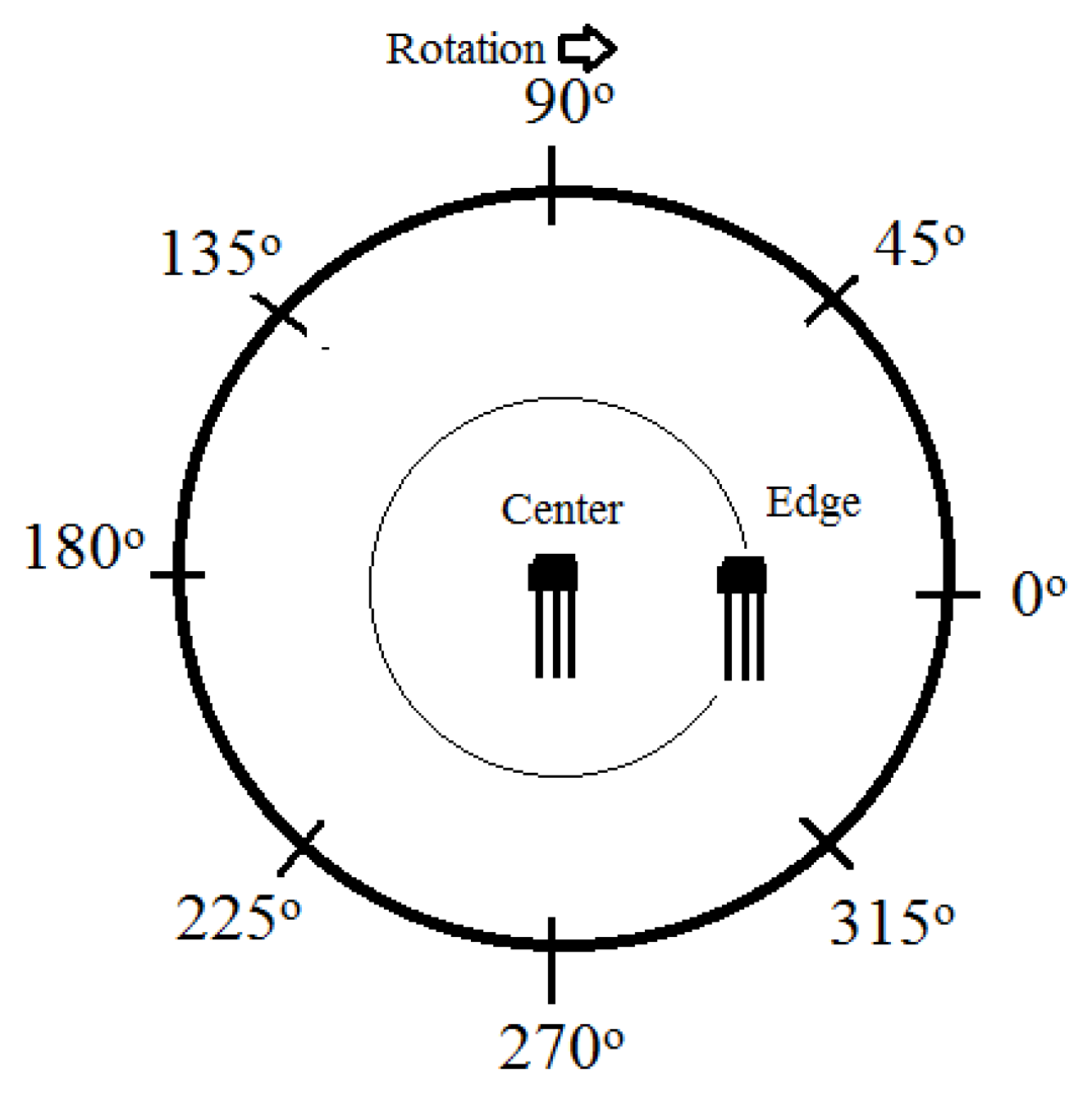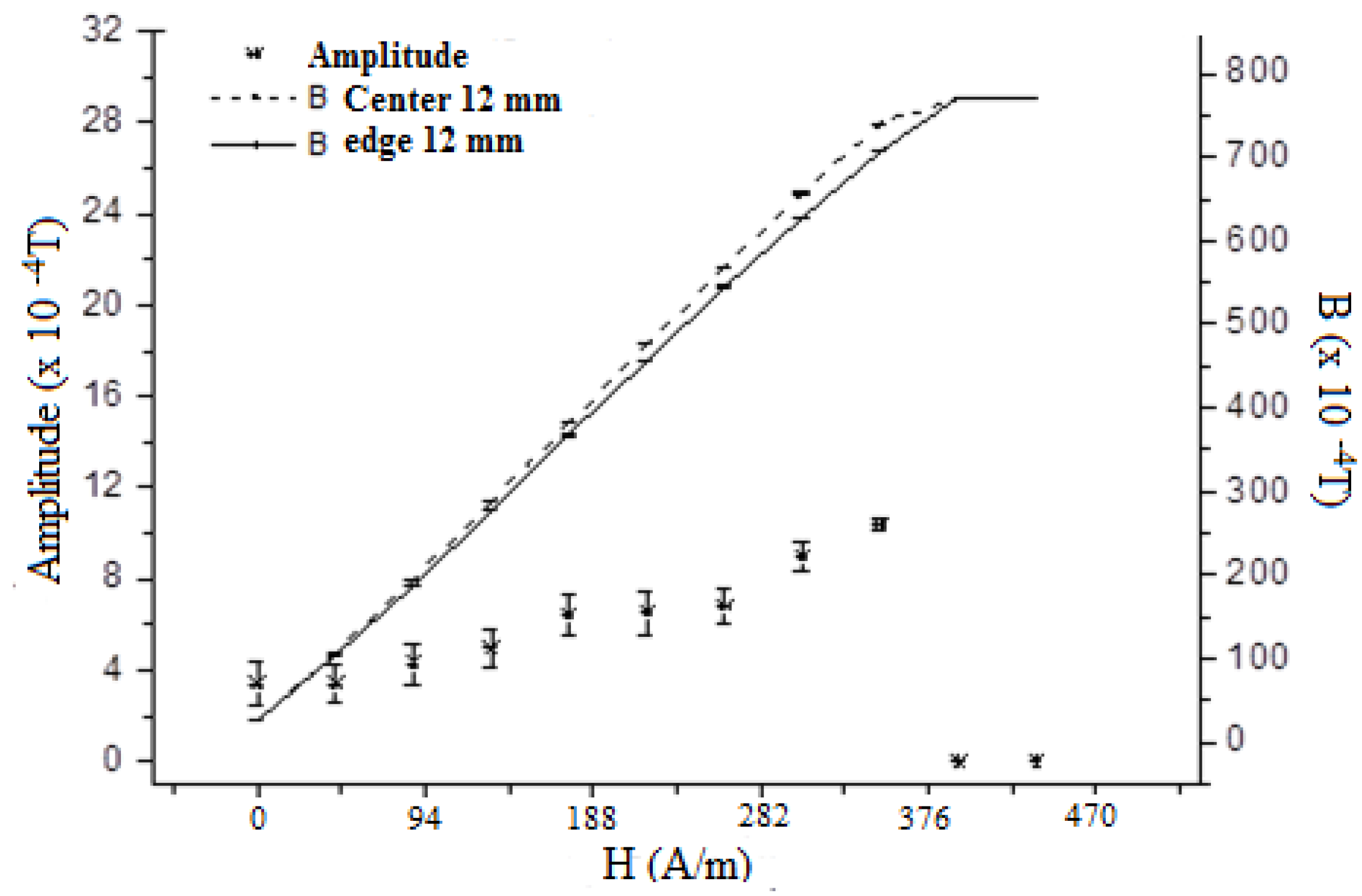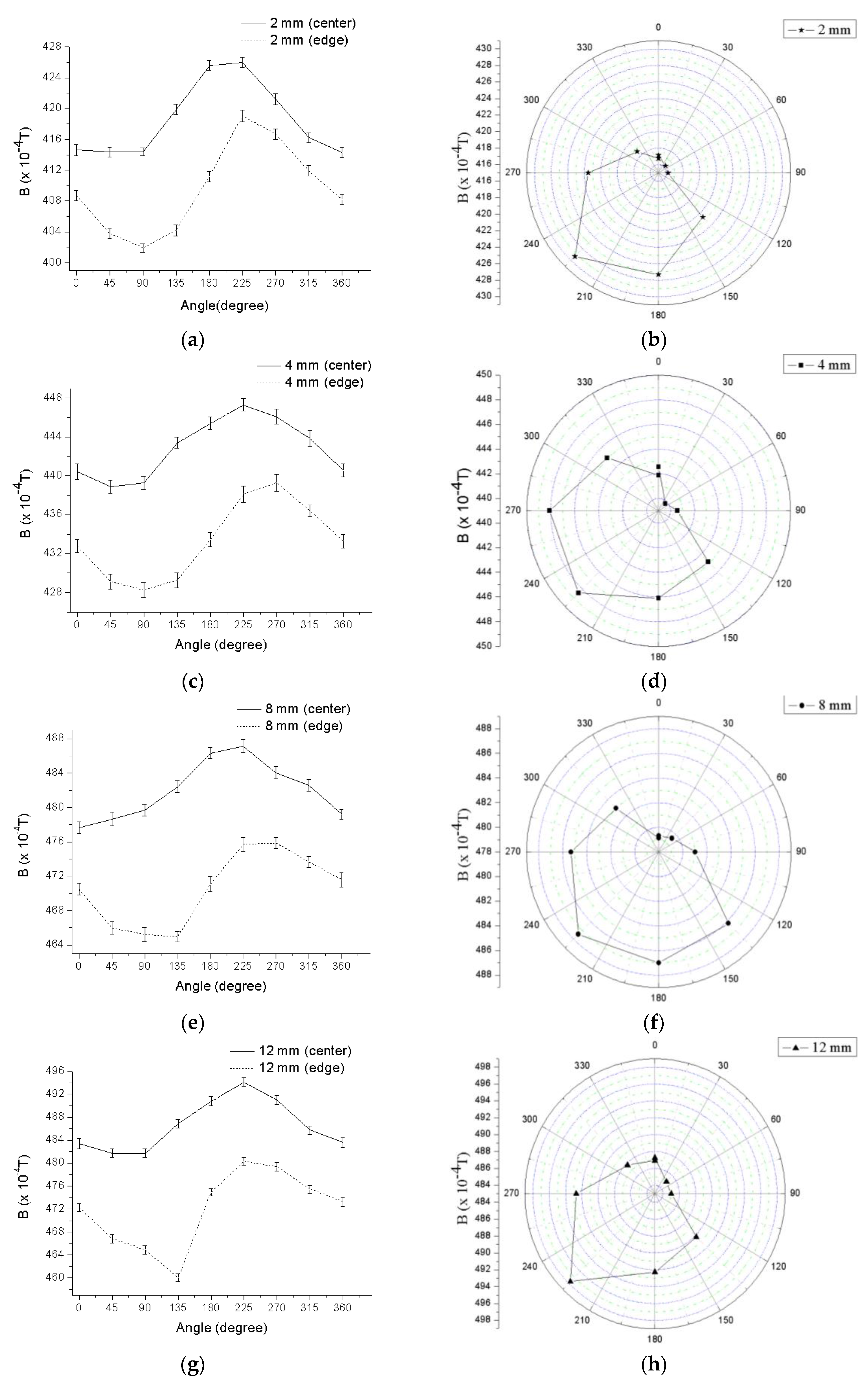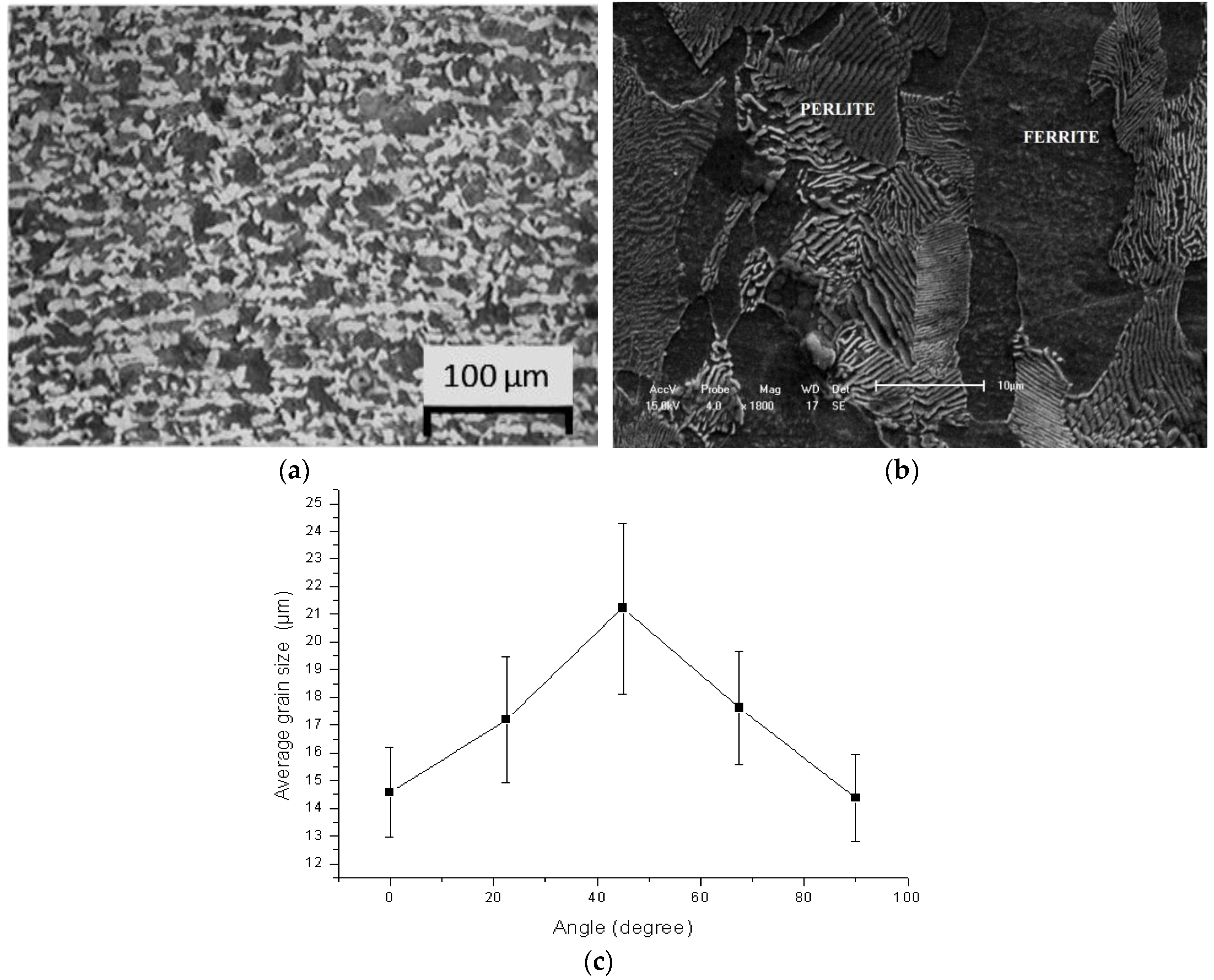Detection of the Magnetic Easy Direction in Steels Using Induced Magnetic Fields
Abstract
:1. Introduction
2. Materials and Methods
3. Results and Discussion
4. Conclusions
- (1)
- The proposed approach can be successfully applied for experimental evaluation of magnetic anisotropy in steels. The approach is non-destructive and can be used in the study of local magnetic properties and of magnetic properties of steels according to different magnetization directions. This approach was also able to determine the magnetization easy direction of the steel studied in samples with different dimensions and even different geometries.
- (2)
- The proposed approach uses direct current to generate an external magnetic field that is applied in the region of magnetic reversibility. This region belongs to the low induction loss region and proved to be sensitive to magnetic anisotropy, which was not observed in other works that only reported findings in the high induced losses region.
Acknowledgments
Author Contributions
Conflicts of Interest
References
- De Albuquerque, V.H.C.; Filho, P.P.R.; Cavalcante, T.S.; Tavares, J.M.R.S. New computational solution to quantify synthetic material porosity from optical microscopic images. J. Microsc. 2010, 240, 50–59. [Google Scholar] [CrossRef] [PubMed]
- De Albuquerque, V.H.C.; de Alexandria, A.R.; Cortez, P.C.; Tavares, J.M.R.S. Evaluation of multilayer perceptron and self-organizing map neural network topologies applied on microstructure segmentation from metallographic images. NDT E Int. 2009, 42, 644–651. [Google Scholar] [CrossRef]
- De Albuquerque, V.H.C.; Silva, E.M.; Leite, J.P.; Moura, E.P.; Freitas, V.L.A.; Tavares, J.M.R.S. Spinodal decomposition mechanism study on the duplex stainless steel UNS S31803 using ultrasonic speed measurements. Mater. Des. 2010, 31, 2147–2150. [Google Scholar] [CrossRef]
- De Albuquerque, V.H.C.; Melo, T.A.A.; Oliveira, D.F.; Gomes, R.M.; Tavares, J.M.R.S. Evaluation of grain refiners influence on the mechanical properties in a CuAlBe shape memory alloy by ultrasonic and mechanical tensile testing. Mater. Des. 2010, 31, 3275–3281. [Google Scholar] [CrossRef]
- Moreira, F.D.L.; Kleinberg, M.N.; Arruda, H.F.; Freitas, F.N.C.; Parente, M.M.V.; de Albuquerque, V.H.C.; Reboucas Filho, P.P. A novel Vickers hardness measurement technique based on Adaptive Balloon Active Contour Method. Expert Syst. Appl. 2016, 45, 294–306. [Google Scholar] [CrossRef]
- Freitas, V.L.A.; de Albuquerque, V.H.C.; Silva, E.M.; Silva, A.A.; Tavares, J.M.R.S. Nondestructive characterization of microstructures and determination of elastic properties in plain carbon steel using ultrasonic measurements. Mater. Sci. Eng. A 2010, 527, 4431–4437. [Google Scholar] [CrossRef]
- Nunes, T.M.; de Albuquerque, V.H.C.; Papa, J.P.; Silva, C.C.; Normando, P.G.; Moura, E.P.; Tavares, J.M.R.S. Automatic microstructural characterization and classification using artificial intelligence techniques on ultrasound signals. Expert Syst. Appl. 2013, 40, 3096–3105. [Google Scholar] [CrossRef]
- Papa, J.P.; Nakamura, R.Y.M.; de Albuquerque, V.H.C.; Falcao, A.X.; Tavares, J.M.R.S. Computer techniques towards the automatic characterization of graphite particles in metallographic images of industrial materials. Expert Syst. Appl. 2013, 40, 590–597. [Google Scholar] [CrossRef]
- Normando, P.G.; Moura, E.P.; Souza, J.; Tavares, S.S.M.; Padovese, L.R. Ultrasound, eddy current and magnetic Barkhausen noise as tools for sigma phase detection on a UNS S31803 duplex stainless steel. Mater. Sci. Eng. A 2010, 527, 2886–2891. [Google Scholar] [CrossRef]
- Chen, S.; Butler, J.; Melzer, S. Effect of asymmetric hot rolling on texture, microstructure and magnetic properties in a non-grain oriented electrical steel. J. Magn. Magn. Mater. 2014, 368, 342–352. [Google Scholar] [CrossRef]
- Chwastek, K. Anisotropic properties of non-oriented steel sheets. IET Electr. Power Appl. 2013, 7, 575–579. [Google Scholar] [CrossRef]
- Emura, M.; Campos, M.F.; Landgraf, F.J.G.; Teixeira, J.C. Angular dependence of magnetic properties of 2% silicon electrical steel. J. Magn. Magn. Mater. 2001, 226–230, 1524–1526. [Google Scholar] [CrossRef]
- Fryskowski, B. Experimental evaluation of magnetic anisotropy in electrical steel sheets. J. Magn. Magn. Mater. 2008, 320, 515–522. [Google Scholar] [CrossRef]
- Qin, J.; Yang, P.; Mao, W.; Ye, F. Effect of texture and grain size on the magnetic flux density and core loss of cold-rolled high silicon steel sheets. J. Magn. Magn. Mater. 2015, 393, 537–543. [Google Scholar] [CrossRef]
- Sonboli, A.; Toroghinejad, M.R.; Edris, H.; Szpunar, J.A. Effect of deformation route and intermediate annealing on magnetic anisotropy and magnetic properties of a 1 wt % Si non-oriented electrical steel. J. Magn. Magn. Mater. 2015, 385, 331–338. [Google Scholar] [CrossRef]
- Chernenkov, Y.P.; Ershov, N.V.; Lukshina, V.A.; Fedorov, V.I.; Sokolov, B.K. An X-ray diffraction study of the short-range ordering in the soft-magnetic Fe-Si alloys with induced magnetic anisotropy. Phys. B Condens. Matter 2007, 396, 220–230. [Google Scholar] [CrossRef]
- Clapham, L.; Heald, C.; Krause, T.W.; Atherton, D.L.; Clark, P. Origin of a magnetic easy axis in pipeline steel. J. Appl. Phys. 1999, 86, 1574–1580. [Google Scholar] [CrossRef]
- Elmassalami, M.; Sousa, I.P.; Areiza, M.C.L.; Rebello, J.M.A.; Elzubair, A. On the magnetic anisotropy of superduplex stainless steel. J. Magn. Magn. Mater. 2011, 323, 2403–2407. [Google Scholar] [CrossRef]
- Fiorillo, F. Anisotropy and magnetization process in soft magnets: Principles, experiments, applications. J. Magn. Magn. Mater. 2006, 304, 139–144. [Google Scholar] [CrossRef]
- Landgraf, F.J.G.; Emura, M.; Teixeira, J.C.; Campos, M.F.; Muranaka, C.S. Anisotropy of the magnetic losses components in semi-processed electrical steels. J. Magn. Magn. Mater. 1999, 196, 380–381. [Google Scholar] [CrossRef]
- Sanchez, J.C.; Benitez, J.P.; Padovese, L.R. Analysis of the stress dependent magnetic easy axis in ASTM 36 steel by the magnetic Barkhausen noise. NDT E Int. 2007, 40, 168–172. [Google Scholar] [CrossRef]
- Gallaugher, M.; Ghosh, P.; Knight, A.M.; Chromik, R.R. The effect of easy axis misorientation on the low induction hysteresis properties of non-oriented electrical steels. J. Magn. Magn. Mater. 2015, 382, 124–133. [Google Scholar] [CrossRef]
- Ortiz, P.M.; Benitez, J.A.P.; Hernandez, J.H.E.; Caleyo, F.; Hallen, J.M. On the estimation of the magnetic easy axis in pipeline steels using magnetic Barkhausen noise. J. Magn. Magn. Mater. 2015, 374, 67–74. [Google Scholar] [CrossRef]
- ASTM International. ASTM E 112–96(2004) Standard Test Methods for Determining Average Grain Size; ASTM International: West Conshohocken, PA, USA, 2004. [Google Scholar]
- Yonamine, T.; Landgraf, F.J. Correlation between magnetic properties and crystallographic texture of silicon steel. J. Magn. Magn. Mater. 2004, 272–276, E565–E566. [Google Scholar] [CrossRef]
- Deme, A.B.; Szabo, I.A.; Cserhati, C. Effect of anisotropic microstructure on magnetic Barkhausen noise in cold rolled low carbon steel. J. Magn. Magn. Mater. 2010, 322, 1748–1751. [Google Scholar] [CrossRef]
- Morgan, M.C.; Padovese, L.R. Fast detection of the magnetic easy axis on steel sheet using the continuous rotational Barkhausen method. NDT E Int. 2012, 45, 148–155. [Google Scholar] [CrossRef]
- Benitez, J.A.P.; Sanchez, J.C.; Padovese, L.R. Characterization of angular dependence of macroscopic magnetic properties in ASTM 36 steel using magnetic Barkhausen noise. NDT E Int. 2007, 40, 284–288. [Google Scholar] [CrossRef]
- Ortiz, P.M.; Benitez, J.A.P.; Hernandez, J.H.E.; Caleyo, F.; Mehboob, N.; Grossinger, R.; Hallen, J.M. Influence of the maximum applied magnetic field on the angular dependence of Magnetic Barkhausen Noise in API5L steels. J. Magn. Magn. Mater. 2016, 401, 108–115. [Google Scholar] [CrossRef]
- Silva, E.M.S.; Leite, J.P.; Neto, F.A.F.; Leite, J.P.; Fialho, W.M.L.; Albuquerque, V.H.C.; Tavares, J.M.R.S. Evaluation of the Magnetic Permeability for the Microstructural Characterization of a Duplex Stainless Steel. J. Test. Eval. 2016, 44, 1106–1111. [Google Scholar]
- Paltanea, V.M.; Paltanea, G.; Gavrila, H.; Dumitru, L. Experimental Analysis of Magnetic Anisotropy in Silicon Iron Steels using the Single Strip Tester. In Proceedings of the 2015 9th International Symposium on Advanced Topics in Electrical Engineering, Bucharest, Romania, 7–9 May 2015; pp. 456–459.
- Landgraf, F.J.G.; Yonamine, T.; Emura, M.; Cunha, M.A. Modelling the angular dependence of magnetic properties of a fully processed non-oriented electrical steel. J. Magn. Magn. Mater. 2003, 254, 328–330. [Google Scholar] [CrossRef]
- Stupakov, O.; Uchimoto, T.; Takagi, T. Magnetic anisotropy of plastically deformed low-carbon steel. J. Phys. D Appl. Phys. 2010, 43, 195003. [Google Scholar] [CrossRef]
- Coey, J.M.D. Magnetism and Magnetic Materials; Cambridge University Press: New Tork, NY, USA, 2010. [Google Scholar]
- Ryu, K.S.; Nahm, S.H.; Kim, Y.I.; Yu, K.M.; Kim, Y.B.; Cho, Y.; Son, D. Nondestructive Evaluation of Residual Life of 1Cr-1Mo-0.25V Steel from Reversible Magnetic Permeability. J. Magn. 2001, 6, 27–30. [Google Scholar]
- Bircakova, R.B.Z.; Kollar, P.; Weidenfeller, B.; Fuzer, J.; Faberova, M.; Bures, R. Reversible and irreversible DC magnetization processes in the frame of magnetic, thermal and electrical properties of Fe-based composite materials. J. Alloy. Compd. 2015, 645, 283–289. [Google Scholar] [CrossRef]
- Cullity, B.D.; Graham, C.D. Introduction to Magnetic Materials, 2nd ed.; Wiley: Hoboken, NJ, USA, 2009. [Google Scholar]
- Grossinger, R.; Keplinger, F.; Mehmood, N.; Hernandez, J.H.E.; Araujo, J.; Eisenmenger, C.; Poppenberger, K.; Hallen, J.M. Magnetic and microstructural investigations of pipeline steels. IEEE Trans. Magn. 2008, 44, 3277–3280. [Google Scholar] [CrossRef]
- Gurruchaga, K.; Guerenu, M.; Gutierrez, I. Sensitiveness of magnetic inductive parameters for the characterization of recovery and recrystallization in cold-rolled low-carbon steel. Metall. Mater. Trans. A Phys. Metall. Mater. Sci. 2010, 41, 985–993. [Google Scholar] [CrossRef]
- Kumar, A.; Misra, A. Shape anisotropy of magnetic field generation during tensile fracture in steel. J. Magn. Magn. Mater. 2005, 285, 71–78. [Google Scholar] [CrossRef]
- Marra, K.M.; Alvarenga, E.A.; Buono, V.T.L. Magnetic aging a nisotropy of a semi-processed non-oriented electrical steel. Mater. Sci. Eng. A 2005, 390, 423–426. [Google Scholar] [CrossRef]






© 2016 by the authors; licensee MDPI, Basel, Switzerland. This article is an open access article distributed under the terms and conditions of the Creative Commons Attribution (CC-BY) license (http://creativecommons.org/licenses/by/4.0/).
Share and Cite
Silva, E.M.; Paula, A.M.R.; Leite, J.P.; Leite, J.P.; Andrade, L.S.S.; De Albuquerque, V.H.C.; Tavares, J.M.R.S. Detection of the Magnetic Easy Direction in Steels Using Induced Magnetic Fields. Metals 2016, 6, 317. https://doi.org/10.3390/met6120317
Silva EM, Paula AMR, Leite JP, Leite JP, Andrade LSS, De Albuquerque VHC, Tavares JMRS. Detection of the Magnetic Easy Direction in Steels Using Induced Magnetic Fields. Metals. 2016; 6(12):317. https://doi.org/10.3390/met6120317
Chicago/Turabian StyleSilva, Edgard M., Alysson M. R. Paula, Josinaldo P. Leite, Joao P. Leite, Lucia S. S. Andrade, Victor Hugo C. De Albuquerque, and Joao Manuel R. S. Tavares. 2016. "Detection of the Magnetic Easy Direction in Steels Using Induced Magnetic Fields" Metals 6, no. 12: 317. https://doi.org/10.3390/met6120317







